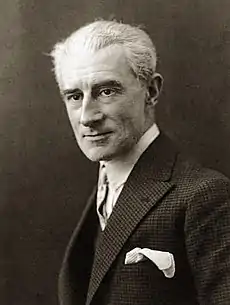Violin Sonata No. 2 (Ravel)
Maurice Ravel composed his Violin Sonata No. 2 for violin and piano from 1923 to 1927. He was inspired by American music, namely jazz and blues.[1]

Ravel, 1925
Inspiration
When the composer was living in Montfort-l'Amaury, France, he accompanied Hélène Jourdan-Morhange, and they shared a love for jazz. The classic blues band of W. C. Handy exhibited the style of St. Louis blues in Paris from 1923 to 1927. Ravel was inspired by the style of music and dance,[2] and jazz elements can also be found in the Piano Concerto for the Left Hand and other works.
Movements
The violin sonata consists of three movements:
References
Notes
- Kelly 2001, p. 868
- Stuckenschmidt 1968, p. 192
Sources
- Kelly, Barbara (2001). "Maurice Ravel". The New Grove Dictionary of Music and Musicians. 20 (2nd ed.). New York: Macmillan.
- Stuckenschmidt, H. H. (1968). Maurice Ravel: Variation on His Life and Work. Philadelphia: Chilton Book Company.
Further reading
- Baer, Susan Irene (1992). The Virtuoso Violin Works of Maurice Ravel: An Analysis of Structural, Technical and Interpretive Features (PDF) (Phd). Texas Tech University.
External links
- Violin Sonata No. 2: Scores at the International Music Score Library Project
- Performance of Violin Sonata No. 2 by Nicola Benedetti (violin) and Julien Quentin (piano) from the Isabella Stewart Gardner Museum in MP3 format
This article is issued from Wikipedia. The text is licensed under Creative Commons - Attribution - Sharealike. Additional terms may apply for the media files.